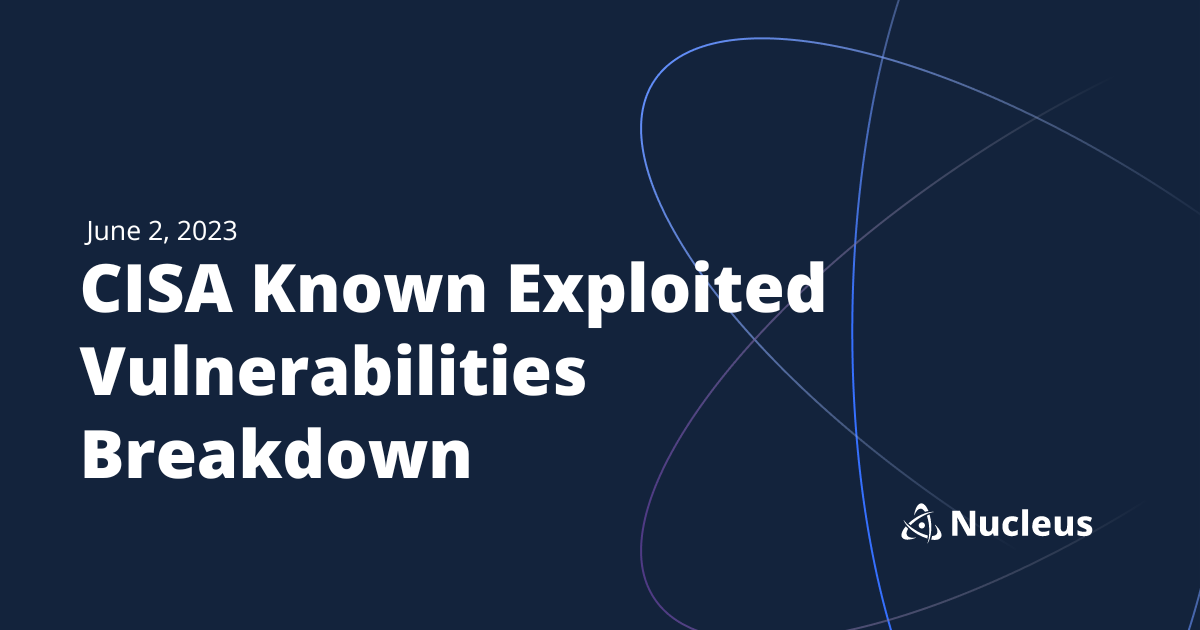June 2, 2023 CISA KEV Breakdown | Progress MOVEit Transfer

June 2: 1 New Vuln | CVE-2023-34362
June 16, 2023 Update: Progress has identified two separate CVEs since disclosing CVE-2023-34362. The first being CVE-2023-35036, the uncovered SQL injection vulnerability known to be the other portion of the attack-chain used to compromise dozens of organization all over the globe, including many in U.S Government. The complete attack-chain was unraveled by Huntress Labs and you can find more information about the discovery and proof of concept in their updated blog here.
The third vulnerability disclosed just yesterday as part of the MOVEit Transfer saga is CVE-2023-35708, a privilege escalation bug that could result in the complete takeover of a system. It is unclear at this time how this vulnerability was uncovered. Progress is urging organizations to treat these two disclosed vulnerabilities with equal severity to CVE-2023-34362, and organizations are encouraged to pull the plug on MOVEit devices and patch as soon as possible.
Progress Disclosure for CVE-2023-35036
Progress Disclosure for CVE-2023-35708
In this CISA KEV Breakdown, only one vulnerability was added, however it has generated quite a lot of buzz within the security community, as it is an uncovered 0-day which defenders are starting the race late to. Earliest exploitation evidence according to the report released by Mandiant began on May 27. In their report, Mandiant details a newly discovered web shell variant by the name of LEMURLOOT.
This malware strain is specifically designed to target MOVEit applications. LEMURLOOT is also reported as having the ability to steal Azure Storage Blob information, including credentials, from the MOVEit Transfer application settings. Primary motive surrounding the active exploitation under investigation by Mandiant points to data theft. They are under the assumption that extortion notes will soon follow to those organizations already affected.
[wptb id=22166]Notable Vulnerability Additions
CVE-2023-34362 | MOVEit Transfer SQLi / Remote Code Execution
A vulnerability in MOVEit Transfer before 2021.0.6 (13.0.6), 2021.1.4 (13.1.4), 2022.0.4 (14.0.4), 2022.1.5 (14.1.5), 2023.0.1 (15.0.1) can allow a remote attacker to gain unauthorized access to the application’s database, with sufficient privileges to execute code. Limited information still exists publicly as to the steps to reproduce exploitation successfully. According to Mandiant, depending on the database engine used in your environment (MySQL, Microsoft SQL Server, Azure SQL, etc) an attacker may be able to infer information about the structure and contents of the database in addition to executing SQL statements that alter the database.
According to the advisory from Progress, the following products are not susceptible to this vulnerability: MOVEit Automation, MOVEit Client, MOVEit Add-in for Microsoft Outlook, MOVEit Mobile, WS_FTP Client, WS_FTP Server, MOVEit EZ, MOVEit Gateway, MOVEit Analytics, and MOVEit Freely. It is also important to note that current evidence suggests that only Transfer servers that are exposed to the public internet are possibly affected.
Progress has released patches for Transfer which can be downloaded directly below.
- MOVEit Transfer 2023.0.1
- MOVEit Transfer 2022.1.5
- MOVEit Transfer 2022.0.4
- MOVEit Transfer 2021.1.4
- MOVEit Transfer 2021.0.6
If the above patches are not available as options for your organization, Progress recommends denying 443 and 80 traffic to MOVEit Transfer. Security vendors and Progress themselves point to this being a SQL injection vulnerability. Huntress is reporting that the vulnerability may include SQLi as a means to elevate privileges, with the *human*.aspx file creating the SQL database account to be used for further access, meaning the vulnerability could be an insecure file upload vulnerability. Detection efforts have been round-the-clock since initial disclosure to the public early June 1. See IoCs and related detection from the huntress post linked above, as well as TrustedSec and Mandiant.
See also this Containment and Hardening guide posted by Mandiant which is a 31 page guide on hardening your MOVEit Transfer application. This document is continuously updated by Mandiant and was last updated today.
GreyNoise has launched a tag to track MOVEit Transfer scanning activity, which can be viewed here.
Security Advisory(s):
https://community.progress.com/s/article/MOVEit-Transfer-Critical-Vulnerability-31May2023
← May 31, 2023 CISA Kev Breakdown
Click here to expand our CISA KEV Breakdown Frequently Asked Questions
- What makes for a notable addition?
- A notable addition can arise from many different characteristics. If a particular vulnerability is notable to the security community or a subset of the security community or if the EPSS score reveals notable information about the vulnerability, this can constitute further analysis. It may also be the case that a particular vulnerability shines a light on everyday users and we will highlight important information and key takeaways to ensure users and readers have easy access to actionable information.
- When is the Breakdown released?
- We aim to have our analysis of each KEV update posted within 24 hours of the time in which the Catalog is updated. See CISA’s full catalog here
- I am not bound by BOD 22-01 or federal regulations, why should the KEV concern me?
- CISA encourages all organizations to utilize the Catalog as an attribute in your vulnerability prioritization framework. Organizations looking to lessen the scope on known dangerous vulnerabilities and make a goal to remediate them can understand where they currently stand against what CISA has confirmed as exploited vulnerabilities in the wild. See CISA’s section on “How should organizations use the KEV catalog?” here.
- What is EPSS?
- EPSS is the Exploit Prediction Scoring System. It is an open, data-driven effort for estimating the likelihood (probability) that a software vulnerability will be exploited in the wild. See the EPSS home page on FIRST for more information here.
- What is the difference between EPSS probability and EPSS percent?
- EPSS probability is the risk calculated by the model when determining the perceived threat of the vulnerability itself. Percentage is a relative comparison of the rest of the CVEs within the given sample. While the probability only changes upon refreshing the results from the model, the percentage can change purely based on the CVE sample given. In the case of the Breakdown, we use the percentage given by the pool of all CVEs with given EPSS data. Scores may vary post-release of the post given new information about the vulnerabilities and their perceived threat. For more information on applying and understanding EPSS data, see this article on the FIRST website, as well as their FAQ page.
- What is GreyNoise?
- GreyNoise is a platform that collects, analyzes, and labels data on IPs that scan the internet and saturate security tools with noise. Through their sensor network, GreyNoise observes vulnerability exploitation attempts for vulnerabilities that are exploited in the wild over the Internet. These are arguably vulnerabilities that should be at the very top of your priority list to remediate.
- Why are GreyNoise exploitation attempts only observed on ~20% of KEV vulnerabilities?
- Exploitation of many vulnerabilities in the CISA KEV will not be observed for many reasons that GreyNoise does a good job of explaining in this post. For example:
- The vulnerability may not be remotely exploitable
- Vulnerability exploitation may require authentication (and result in privilege escalation)
- The impacted software may not be exposed to the internet
- Mass scanning/exploitation is not occurring yet
- Exploitation of many vulnerabilities in the CISA KEV will not be observed for many reasons that GreyNoise does a good job of explaining in this post. For example:
See Nucleus in Action
Discover how unified, risk-based automation can transform your vulnerability management.






























